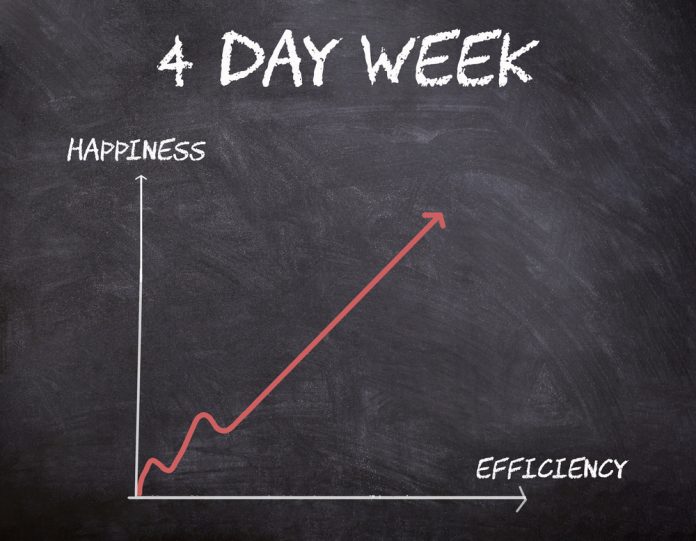
Recently, 33 businesses in the U.S. and Ireland and a large multinational company in the UK, Australia, and New Zealand conducted a pilot program on the four-day workweek. The findings were clear: Employees’ well-being surged, productivity rose, and the companies’ revenue rose.
The results were so positive that most of the companies decided to continue the four-day workweek even after the study finished. Indeed, some participating employees reported that no amount of money could entice them to return to a five-day workweek.
At a time when many businesses struggle to hire talented employees, savvy managers have started to consider new ways of appealing to prospective workers. Offering a four-day workweek presents a potential solution that merits not just serious consideration but also experiments with implementation.
The Four-Day Workweek Explained
The idea behind the four-day workweek is that prioritizing employees’ well-being helps businesses’ bottom lines. This strategy has been part of a Lean Business Enterprise approach and has been paying off. Giving workers a substantial amount of time away from work each week tends to make them feel recharged upon their return. As a result, they tend to work harder, which translates into boosted productivity.
Different businesses decreased employees’ hours in different ways. Some chose to keep the five-day week but reduced each day’s hours by 20 percent, while others allowed staff to choose one day or two afternoons off per week. None of the companies in the pilot program required their employees to continue working 40 hours per week, and there was no reduction in pay.
Importantly, effective four-day workweek programs avoid asking employees to do more with less time, which would cause stress and make workers feel more overburdened than they did before. Attempting to meet productivity targets in less time without a proper appreciation of the overall value stream creates a culture of anxiety and frustration, which is counterproductive.
Some business leaders and managers may find it difficult to trust their employees and relax their expectations. However, the research indicates that these adjustments eliminate waste, not productivity.
An Addition—Not a Substitute
The four-day workweek is not a replacement for other measures that have proven their effectiveness for both employees and employers, such as remote work, hybrid work, flexible work schedules, the right to disconnect, and unlimited paid time off. In my experience, hiring initiatives improve exponentially when employers offer a personalized work environment that enables innovative and creative employees to fulfill their own needs.
For example, in the recent book, “When: The Scientific Secrets of Perfect Timing,” New York Times best-selling author Daniel H. Pink found that most people work best in the mornings, while others tend to work best in the evenings. But few, if any, work well during the afternoon.
Allowing employees to determine their own hours means they will typically choose to work when they can best produce. As a recent article in Forbes points out, “Workers with full schedule flexibility report 29 percent higher productivity and 53 percent greater ability to focus than workers with no ability to shift their schedule.”
Employers who remain wedded to the traditional 9-to-5 workday try to force people to be productive at times when this usually doesn’t come naturally. This can mean they pay their workforce to function poorly for half the day. According to the BBC, “many workers spend chunks of time in an eight-hour workday scrolling through social media, shopping online, or sending texts. One 2015 study showed that workers can spend up to 2.5 hours a day cyberloafing on the job.”
How to Implement the Four-Day Workweek
The best approach when implementing the four-day workweek is to stagger the regular working hours of different employees. For instance, some would work from Monday to Thursday, while others would work from Tuesday to Friday.
This is beneficial because it ensures your company remains responsive to clients and business partners during the entire five-day workweek. It also enables communication and interaction among shifts and staff members and continual problem-solving ability.
In addition, many employees benefit from times when they can concentrate uninterrupted or with fewer demands on their attention. This is especially true for employees and managers who routinely engage in higher-order thinking or tasks demanding greater creativity.
To design a four-day workweek for your business, start by assessing its current state and envision its ideal future. Then, use Value Stream Mapping (VSM) to take a holistic view of your company’s ecosystem, including employee well-being and preferences, business objectives and efficiency, and customer value. As a tool that helps businesses eliminate waste and achieve goals, VSM can identify how best to bridge the gap between where you are now and where you want to go.
Will Employers Listen?
Some sectors of the U.S. economy have already moved to four-day workweeks. Manufacturing, for instance, made this change even before the COVID-19 pandemic. Therefore, it is reasonable to anticipate that other U.S. sectors will follow suit and adopt the four-day workweek.
In today’s competitive world, employers that don’t offer this benefit may find themselves increasingly at a disadvantage, falling behind on both employee retention and performance.




